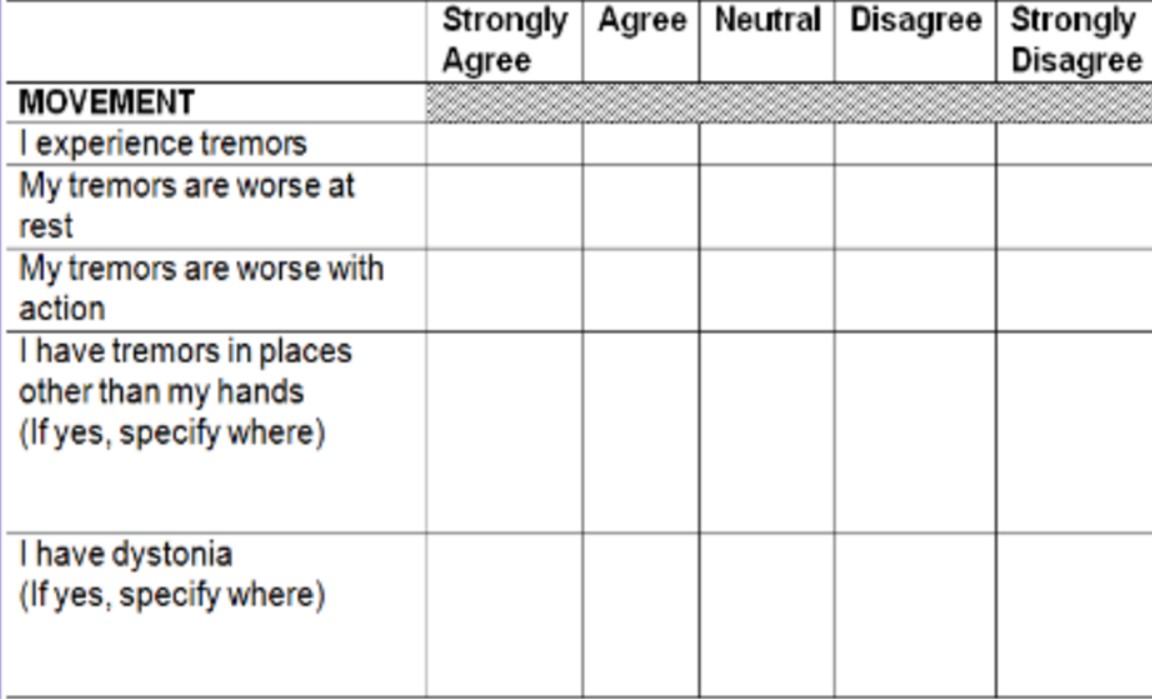Session Information
Date: Tuesday, June 6, 2017
Session Title: Tremor
Session Time: 1:45pm-3:15pm
Location: Exhibit Hall C
Objective: The aim of this study is to evaluate the characteristics of PoTS associated tremor.
Background: Postural tachycardia syndrome (PoTS) is a dysautonomia most prevalent in young women and children. Its most classic presentation is an increase in heart rate of at least 30 beats per minute (bpm) within 10 minutes of standing in adults, or of at least 40 bpm in children in the absence of orthostatic hypotension.
Methods: Thirty patients with POTS completed a 37 item questionnaire about movement disorders including tremor and dystonia. Responses were elicited on a five-point Likert scale by converting the responses into integers (strongly disagree=1, disagree=2, neutral=3, agree=4, strongly agree=5). Frequency of positive responses (strongly agree and agree), median, and interquartile ranges were calculated using Microsoft Excel and graphed using StatPlus.
Results: Our analysis shows that approximately 53% of PoTS patients reported tremors (n=30). Thirty three percent report tremors in areas other than the hands; 10% report ocular involvement, 3% report lip tremor, 10% report arm involvement, 10% report leg involvement, 7% report foot involvement, 3% report head tremor, and 3% report general upper body tremor. Only 3% of the POTS patients reported dystonia. In addition to the twenty seven percent of patients that noted that their tremors became worse with action, another twenty percent of patients reported that their tremors were worse at rest, contradicting the findings of current (Abdulla and Rajeevan, 2016).
Conclusions: PoTS is primarily felt to be a disease of orthostatic intolerance. The heterogeneity of the disorder may stem from comorbidities rather than the syndrome itself (Benarroch, 2012). The movement disorders noted in this PoTS population included tremor and dystonia. The reported tremors represented a mixed picture of both rest and action tremors with and without orthostatic exacerbation. Orthostatic intolerance has been associated with tremor, light-headedness, fatigue, exercise intolerance and near syncope in upright posture (Agarwal et al, 2007; Benarroch, 2012). However, our study demonstrates movement disorders in standing as well as seated positions and also shows that these POTS tremors are not purely action tremor (Hua et al, 2004; Elble, 2013).
References: Deb A, Morgenshtern K, Culbertson CJ, Wang LB, Hohler AD. A survey-based analysis of symptoms in patients with postural orthostatic tachycardia syndrome. Proc (Bayl Univ Med Cent). 2015 Apr; 28(2):157-9. PMID: 25829642
Huang H, Hohler AD. The Dermatological Manifestations of Postural Tachycardia Syndrome: A Review with Illustrated Cases. Am J Clin Dermatol. 2015 Oct; 16(5):425-30. PMID: 26242228
To cite this abstract in AMA style:
R. Pyda, A. Hohler. A survey-based analysis of abnormal movements in patients with Postural Tachycardia Syndrome (PoTS) [abstract]. Mov Disord. 2017; 32 (suppl 2). https://www.mdsabstracts.org/abstract/a-survey-based-analysis-of-abnormal-movements-in-patients-with-postural-tachycardia-syndrome-pots/. Accessed December 29, 2025.« Back to 2017 International Congress
MDS Abstracts - https://www.mdsabstracts.org/abstract/a-survey-based-analysis-of-abnormal-movements-in-patients-with-postural-tachycardia-syndrome-pots/

